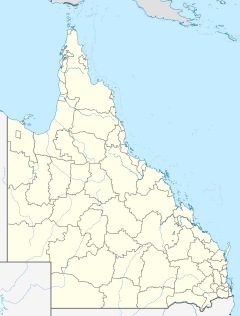25°09′17″S 141°20′31″E / 25.15471°S 141.34204°E

Currawilla Station is a pastoral lease that currently operates as a cattle station in Queensland.
It is located approximately 135 kilometres (84 mi) west of Windorah and 217 kilometres (135 mi) east of Birdsville in Queensland. The property adjoins Palparara[1] and Narradunna Stations.[2] It is situated in the Channel Country and is well watered by numerous creeks in the area. The homestead is found along the Currawilla waterhole on the Torrens Creek.[3] Farrar's Creek also runs through the property.[4]
It was established at some time prior to 1878,[5] by Jack Farrar on Karuwali tribal lands. Farrar had worked at McGregor's Mount Margaret Station and kept his own herd. Farrar later left and followed the Diamantina River down the Channel Country and took up a block about 100 square miles (259 km2) on Farrar's Creek and named it Currawilla after the Aboriginal name for a waterhole. Farrar later sold it to Mr Cotton who substantially increased the size of the holding.[4]
In 1881 it was sold by Messrs Cotton and Malpas[6] to Messrs Martin and Johnston.[4] At this time Currawilla occupied an area of 1,300 square miles (3,367 km2) and was stocked with 4,000 cattle and 60 horses.[6] In 1887 the heaviest flooding known at the time following exceptionally heavy rains in the area, Currawilla recorded 11 inches (279 mm) over a two-day period.[7] In 1887 the property was managed by William Henry Watson.[8] The owners of the station in 1889 were Messrs Edward Martin and Company of Melbourne.[3] Drought struck in 1897 but it was less severe at Currawilla compared to many surrounding properties.[9] Eventually in 1889,[10] Watson, who was still managing the property, bought it outright.[4]
In 1914 Currawilla was sold by Watson to the Bergin brothers. The 1,120-square-mile (2,901 km2) property was stocked with approximately 6,000 head of cattle and 150 horses.[11]
The property currently occupies an area of 2,230 square kilometres (861 sq mi) and is owned and run by Roger and Debbie Oldfield.[12]
See also
editReferences
edit- ^ "Million Acre Property". The Charleville Times. Brisbane, Queensland: National Library of Australia. 31 December 1936. p. 1. Retrieved 1 October 2014.
- ^ "Classified Advertising". The Queenslander. Brisbane, Queensland: National Library of Australia. 5 September 1885. p. 371. Retrieved 1 October 2014.
- ^ a b "From Windorah to Birdsville". Morning Bulletin. Rockhampton, Queensland: National Library of Australia. 19 December 1889. p. 3. Retrieved 1 October 2014.
- ^ a b c d "History of Currawilla". Townsville Daily Bulletin. Queensland: National Library of Australia. 24 November 1938. p. 3. Retrieved 2 October 2014.
- ^ "Richmond river". The Queenslander. Brisbane, Queensland: National Library of Australia. 12 July 1879. p. 57. Retrieved 1 October 2014.
- ^ a b "Commercial". The Brisbane Courier. Queensland: National Library of Australia. 5 July 1881. p. 2. Retrieved 1 October 2014.
- ^ "Queensland News". The Brisbane Courier. Queensland: National Library of Australia. 22 March 1887. p. 5. Retrieved 1 October 2014.
- ^ "The Barcoo". Morning Bulletin. Rockhampton, Queensland: National Library of Australia. 15 July 1887. p. 3. Retrieved 1 October 2014.
- ^ "The Drought in Queensland". The Brisbane Courier. Queensland: National Library of Australia. 11 June 1897. p. 6. Retrieved 1 October 2014.
- ^ "Fartherest West in Queensland". The Queenslander. Brisbane, Queensland: National Library of Australia. 27 December 1902. p. 1921. Retrieved 2 October 2014.
- ^ "Sale of Currawilla Station". The Morning Bulletin. Rockhampton, Queensland: National Library of Australia. 3 August 1914. p. 6. Retrieved 2 October 2014.
- ^ "Three for the Road". David Adams Films. 2014. Archived from the original on 1 October 2014. Retrieved 1 October 2014.
